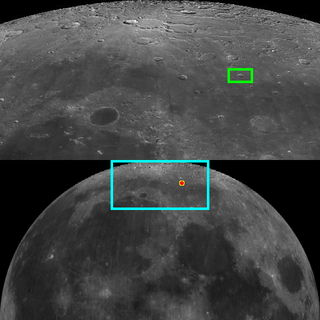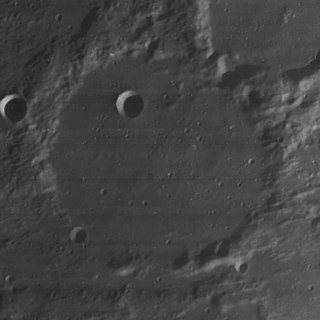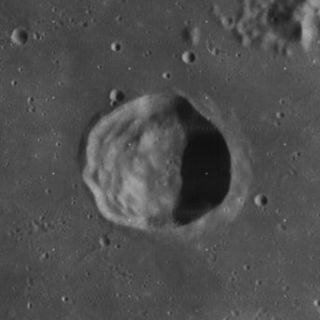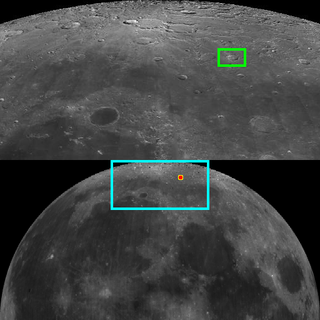
Aristoteles is a lunar impact crater that lies near the southern edge of the Mare Frigoris and to the east of the Montes Alpes mountain range. It was officially named in 1935 after the ancient Greek philosopher Aristotle by the International Astronomical Union, using the classical form of his name.

Aryabhata, named after Indian astronomer Aryabhata, is the remnant of a lunar impact crater located in the eastern Mare Tranquillitatis. The crater has been almost submerged by lava-flow, and now only an arc-shaped ridge formed from the eastern half of the rim remains above the lunar mare. This crater was previously identified as Maskelyne E before being named by the IAU in 1979. Maskelyne itself is to the southwest.
Abetti is a lunar impact crater that has been completely submerged by mare lavas. It forms a 'ghost crater' in the surface, showing only a curved rise where the rim is located. Abetti is located near the southeast edge of Mare Serenitatis, to the west of the Mons Argaeus. This crater is generally visible only at low angles of illumination. It is named after two Italian astronomers, Antonio Abetti and his son Giorgio.

Mitchell is a lunar impact crater, which is attached to the eastern rim of the larger and more prominent crater Aristoteles. It was named after American astronomer Maria Mitchell. The floor of Mitchell is rough and irregular, with a low central rise, being partially filled with the ejecta of the younger Aristoteles. There is a slight notch in the southern rim, and the western wall has been completely absorbed by the rim of Aristoteles.

Galle is a small lunar impact crater on the Mare Frigoris, to the north-northeast of the prominent crater Aristoteles. The formation is nearly circular, with a sharp-edged rim and little appearance of erosion. There are slight outward bulges in the rim to the north and northeast, but otherwise the formation is relatively symmetrical.

Sheepshanks is a small lunar impact crater located near the northern edge of Mare Frigoris. Due south on the opposite shore is the prominent crater Aristoteles while to the north is C. Mayer. Sheepshanks appears somewhat oblong due to foreshortening, but it is actually nearly circular. The inner walls slope down to a ring of material around the inner floor. There is a small craterlet along the southeastern inner wall. The crater is otherwise not particularly eroded by impacts.

Eudoxus is a prominent lunar impact crater that lies to the east of the northern tip of the Montes Caucasus range. It is named after the Greek astronomer Eudoxus of Cnidus. It is located to the south of the prominent crater Aristoteles in the northern regions of the visible Moon. To the south is the ruined formation of Alexander, and the small crater Lamèch lies to the southwest.

Abel is an ancient lunar impact crater that lies near the southeast limb of the Moon's near side. It is located to the south of the crater Barnard, at the northwest edge of the Mare Australe.

Encke is a lunar impact crater that is located on the western edge of the Mare Insularum, to the south-southeast of the crater Kepler. The small crater Kunowsky lies to the east-southeast on the mare.

Arnold is a lunar impact crater that is located in the north-northeastern part of the visible Moon, near the lunar limb. This location gives the crater a notably oval appearance due to foreshortening, although the formation is actually relatively round. It lies to the northeast of the Mare Frigoris, to the north of the crater Democritus. West of Arnold is the smaller crater Moigno.

Baily is the remnant of a lunar impact crater on the boundary between Mare Frigoris to the north and Lacus Mortis to the south. The crater interior has been flooded by lava in the past, and only the northern half of the crater rim remains relatively intact. There is an outward bulge in the northeastern rim, possibly the remnant of another crater formation that once overlapped Baily. The crater interior is flat and relatively featureless, with no impacts of significance. The surviving outer rim reaches a maximum elevation of about 0.5 km.

Fontenelle is a lunar impact crater that is located along the northern edge of Mare Frigoris, in the northern part of the Moon. To the northeast is the remnant of the crater Birmingham. Due to its location, this crater appears oval in shape when observed from the Earth because of foreshortening.

Protagoras is a lunar impact crater that is located on the Mare Frigoris in the northern part of the Moon. To the north-northwest is the slightly larger crater Archytas, and to the southeast is the prominent Aristoteles.

C. Mayer is a lunar impact crater that is located at the northern edge of the Mare Frigoris, due north of the prominent crater Aristoteles. Also to the south, but only a third as distant, is the smaller crater Sheepshanks. Due east of C. Mayer is the flooded crater Kane.

Cook is a lunar impact crater that lies in the western part of the Mare Fecunditatis, just to the southeast of the prominent crater Colombo. To the southwest is Monge.

Fabbroni is a small lunar impact crater that lies along the northern edge of the Mare Tranquillitatis, at the eastern edge of the gap where the lunar mare joins Mare Serenitatis to the north. To the southeast is the crater Vitruvius.

Dechen is a small, bowl-shaped crater that is located in the northwest part of the Oceanus Procellarum, near the northwest limb of the Moon. The rim of the crater projects slightly above the surrounding lunar mare, and the interior is symmetrical and nearly featureless. It lies to the northeast of the crater Harding, but is otherwise relatively isolated.

Daubrée is a lunar impact crater that is located to the southwest of the Mare Serenitatis, just to the west-southwest of the crater Menelaus in the Montes Haemus range. The small lunar mare Lacus Hiemalis lies along the southwest rim of Daubrée. The crater was named after French geologist Gabriel A. Daubrée. It was previously designated Menelaus S.

Kunowsky is a small lunar impact crater on the Mare Insularum, in the western half of the Moon's near side. It is named after the German astronomer Georg Karl Friedrich Kunowsky. It lies about one third the distance from Encke to the west-northwest and Lansberg to the east-southeast.

Erro is a lunar impact crater that lies beyond the eastern limb of the Moon, on the far side as seen from the Earth. It lies along the eastern fringes of the uneven plain that joins Mare Marginis to the northwest with Mare Smythii to the west-southwest. This part of the surface is sometimes brought into sight of observers on the Earth due to libration. However even at such times not much detail can be seen, as the surface is viewed from the edge.























